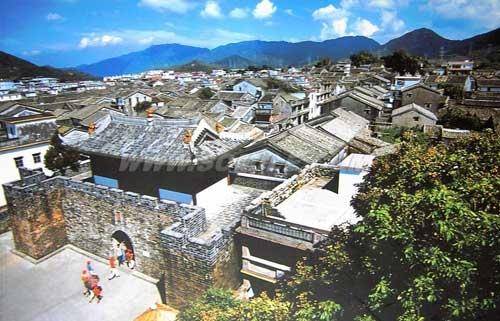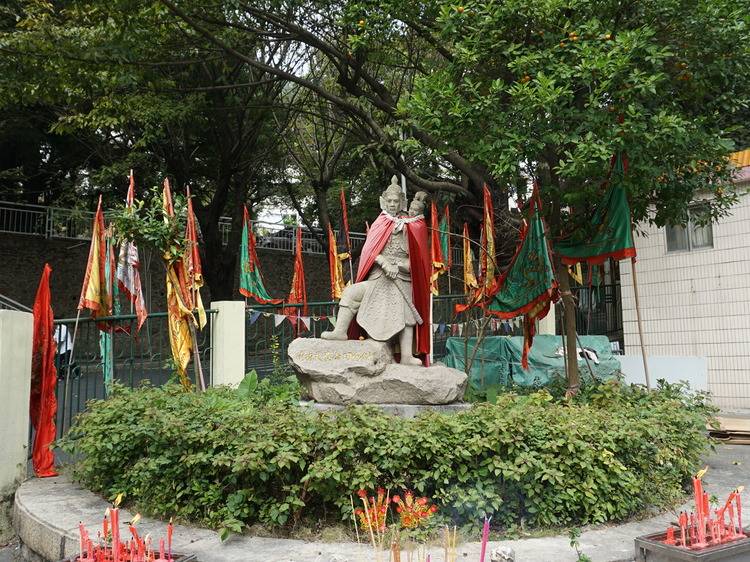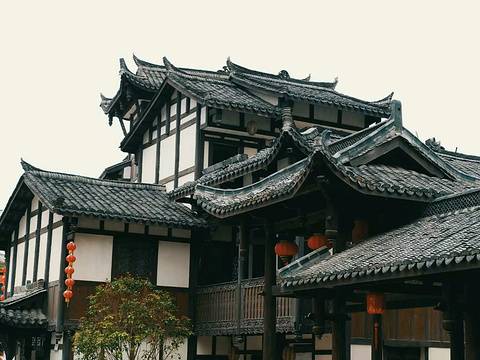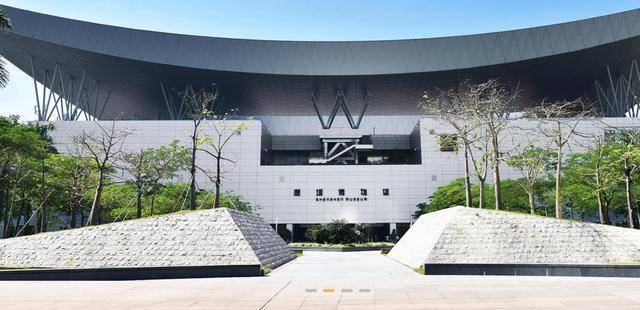Dapeng Fortress, also known as 'Dapeng Guard Thousand-Household Fortress,' is one of the eight major attractions in Shenzhen and a national cultural heritage site. It is also the reason why Shenzhen is still known as 'Pengcheng.' Located in Pengcheng Village, Dapeng Town, Dapeng New District, Longgang, Shenzhen, it covers an area of 110,000 square meters. It was first built in the 27th year of the Hongwu reign of the Ming Dynasty (1394 AD). The fortress has an irregular quadrilateral layout with three main streets: East Gate Street, South Gate Street, and Main Street. Major buildings include the Left Camp Office, Deputy General's Office, Defense Office, Military Uniform Bureau, Gunpowder Bureau, Guandi Temple, Zhao Gong Shrine, and Tianhou Temple. The original layout is largely preserved, and the east, west, and south gates are still intact. The main existing buildings inside the fortress include the General Zhenwei's Residence and General Liu Qilong's Residence, which are grand in scale and well-preserved.
Dongshan Temple
Shenzhen Dapeng Dongshan Temple is located in Pengcheng Village, Dapeng Town, Longgang District, Shenzhen City, on the southern hillside of Longtoushi Mountain. It overlooks Daya Bay, with mountains behind and the sea in front, offering extremely elegant and beautiful scenery. Dongshan Temple was first built in the 27th year of the Hongwu reign of the Ming Dynasty (1394 AD). A famous feng shui master, Lai Buyi, traveled to Dapeng Bay and passed by Longtoushi Mountain in Dongshan. He discovered a purple glow, which he identified as an auspicious light, and informed the local villagers that this was a blessed place. He suggested building a temple here to ensure the safety of the area, leading to the construction of Dongshan Temple. The temple has undergone three major renovations in its history. The first renovation took place in the spring of the fourth year of the Xianfeng reign of the Qing Dynasty (1854). In 1993, local residents, along with compatriots from Hong Kong, Macau, and overseas Chinese, voluntarily donated over one million yuan for the second renovation of Dongshan Temple. The third renovation was carried out in 2009.
Guanlan Printmaking Village, one of the top ten Hakka ancient villages in Shenzhen, is located in the hometown of Chen Yanqiao, a pioneer of the new woodcut movement in China, a famous printmaker, and an art theorist. The total planned area of Guanlan Printmaking Village is 1.4 million square meters, with a central area of 316,000 square meters. The village integrates printmaking and Hakka ancient village elements, blending Hakka cultural themes with modern landscape elements. It is located in Niuhu Community, Guanlan Street, Longhua District, Shenzhen.
Nantou Ancient City (also known as Xin'an Ancient City) is located 8 meters north of Nantou Overpass in Nanshan District, Shenzhen (next to Shennan Avenue), covering an area of about 70,000 square meters. It is currently the largest historical and cultural tourist attraction in Shenzhen, also known as Nantou Ancient City, with a long history of over 1,730 years.
Chiwan Left Fort
The Chiwan Ancient Fort, also known as the Left Fort, is located at the tip of the Shekou Peninsula, which 'commands the danger from three sides of the coastal mountain ridge.' It was first built in the eighth year of the Kangxi reign of the Qing Dynasty (1669). Originally, there were left and right forts with a total of 12 cast iron cannons. Now, only the left fort remains well-preserved. It was restored in 1985. The Chiwan Fort, perched on the mountain and facing the sea, with the left and right forts forming a horn-like position, controlled the Chiwan Port and commanded the Lingding Sea. It was a major maritime defense during the Opium War.
Chiwan Tianhou Temple
Chiwan Tianhou Temple, also known as Tianhou Museum, is located beside Chiwan Village in Nanshan District, Shenzhen City, Guangdong Province, at the foot of Xiaonan Mountain. It is surrounded by mountains and sea, with beautiful scenery. Its creation dates back to the Song Dynasty, and its construction is magnificent. It was renovated multiple times during the Ming and Qing Dynasties, gradually expanding in scale. In the early Ming Yongle period, Admiral Zheng He, under the command of Emperor Yongle Zhu Di, led a fleet to the Western Seas, pioneering the maritime 'Silk Road'. Chiwan Tianhou Temple was an important stop for them. The 'Chiwan Scenic Area' centered around Chiwan Tianhou Temple was one of the 'Eight Scenic Spots of Xin'an' during the Ming and Qing Dynasties.
Chiwan Tomb of Song Shaodi
The Tomb of Song Shaodi, initially known as the Tomb of Song Shaodi, is the mausoleum of Zhao Bing, the last emperor of the Southern Song Dynasty. It is located near Shaodi Road and Chiwan Park in Chiwan Village, Zhaoshang Subdistrict, Nanshan District, Shenzhen City, Guangdong Province, China. It is the only imperial tomb of the Song Dynasty within Guangdong Province. The Tomb of Song Shaodi is one of the first batch of key cultural relics protection units in Shenzhen.
Hehu New Residence, one of the top ten Hakka ancient villages in Shenzhen, was built during the Qianlong period of the Qing Dynasty. It is a provincial-level cultural relic protection unit in Guangdong Province and serves as a historical witness to the Hakka people's development of the Shenzhen area. It provides important evidence for the study of Shenzhen's history, culture, customs, and architecture.
Maosheng Shiju
Maosheng Shiju (He Family), also known as 'Maosheng Wei', is located on Maosheng Road, Henggang Street, Shenzhen. Maosheng Shiju was built during the Jiaqing period of the Qing Dynasty, with a history of over 200 years. It is a large Hakka walled house that uniquely integrates Cantonese residential and European architectural styles in Shenzhen.
Jikeng Ancestral Residence
Jikeng Ancestral Residence is located in Liulian Village, Pingdi Town, Longgang District, Shenzhen City (Xiao family). It was built in the Jia Shen year of the Daoguang period of the Qing Dynasty (1824) with an orientation of 45° south by southwest. In front of it, there is a moon pond and a threshing ground. The total width is 67 meters, and the depth is 72 meters. The structure is a castle-style enclosed building with three halls, two courtyards, two horizontal wings, one enclosure, four corner towers, and one watchtower. The total area is 7,370 square meters.
Xinqiao Ancestral Residence
The Xinqiao Ancestral Residence of the Xiao family in Gaoqiao Village is a Hakka walled village located on the north side of Gaoqiao Village, Pingxi Administrative Village, Pingdi Town, Longgang District, Shenzhen City. It has a layout of three halls and four horizontal sections, facing 20° east-southeast. The total width is 120 meters, and the depth cannot be accurately measured due to the destruction of the rear part, covering an area of approximately 15,600 square meters. It is of timber and earth construction. In front, there is a large and complete moon pond, 102 meters long and 35 meters wide. The threshing ground is also spacious. The front has five gates. The Xinqiao Ancestral Residence is basically well-preserved, with some parts currently inhabited. It is also registered as an immovable cultural relic of Longgang District.
Gankeng Hakka Town
Gankeng Hakka Town is one of the top ten Hakka ancient villages in Shenzhen. It is a diverse and complex tourist destination created by the OCT Group, integrating local folklore, rural leisure, ecological vacation, cultural display, and science education in Shenzhen. It is also an important window to understand the indigenous culture of Shenzhen. Gankeng Hakka Town features Hakka residences and numerous ancient buildings, nestled among mountains and rivers, with interconnected houses and alleys, creating a picturesque scene. Additionally, it includes scenic buildings such as ancient watchtowers, Qingxin Alley, Zhuangyuan Mansion, and Phoenix Valley, blending into the natural landscape and forming a unique Hakka cultural carrier with the centuries-old Hakka row houses. The development direction of Gankeng is to recreate the central OCT of Shenzhen, giving Shenzhen residents a period of slow-paced life.
Dawan Ancestral Residence (Zeng Clan) is one of the top ten Hakka ancient villages (ancient residences) in Shenzhen and also a provincial-level cultural relic protection unit in Guangdong Province. Located at No. 33 Dawan Road, Pinghuan Community, Pingshan District, Shenzhen, it is a castle-style Hakka walled house. Built during the Qianlong period of the Qing Dynasty (1736-1795), it covers an area of 15,000 square meters and is one of the largest square Hakka walled houses in the country.
The Dongjiang Guerrilla Memorial Hall is located in Sanyang Lake, Pingshan New District, Shenzhen, an important activity area of the Dongjiang Guerrilla. The hall was initiated by the Shenzhen Dongjiang Guerrilla Veterans Association, with full cooperation from the Pingshan Town Committee and Town Government. It has received strong support and sponsorship from veterans' associations of Dongjiang and Bianjiang, local residents of revolutionary old areas in Shenzhen, the business community in Shenzhen, patriotic individuals from Hong Kong and Macau, and overseas compatriots. The hall was completed in May 2000 and officially opened on December 2.
Shajing Zeng Clan Ancestral Hall
The Zeng Clan Ancestral Hall is a clan ancestral hall building of the Zeng family, located in Xinqiao Village, Shajing Town, Bao'an District. The main building is the Zeng Clan Ancestral Hall, which, together with the Guanyin Tianhou Temple, the Guqiao Zeng Gong Ancestral Hall, and the Martial Arts Hall, forms a large architectural complex. It was established in the late Song Dynasty. The current building dates back to the Qianlong period of the Qing Dynasty, with the most recent renovation in 2005. On July 17, 2002, it was announced as the fourth batch of key cultural relics protection units in Guangdong Province. The Zeng Clan Ancestral Hall represents an excellent cultural form of ancestor worship, with significant influence and historical value. It is the only ancestral hall building in Shenzhen with five bays and a paifang (archway), and it is also one of the best-preserved ancestral halls.
Shenzhen Museum
Shenzhen Museum is located in Area A of the Civic Center on Fuzhong Road, Futian District, Shenzhen City, Guangdong Province. It is bordered by Lianhua Mountain Park to the north and Shennan Avenue to the south. It is a comprehensive museum mainly focused on local history and serves as the center for cultural relic collection and historical research in Shenzhen. Although Shenzhen Museum is not considered a historical site, it preserves many cultural relics and plays a crucial role in understanding the history of Shenzhen.



































